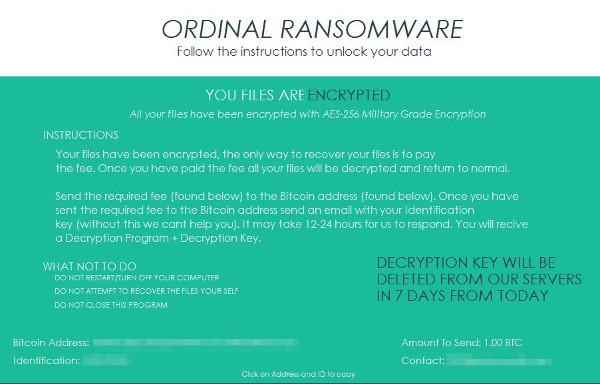RANSOM_HIDDENTEARORDINAL.A
Ransom.BTCWare (Malwarebytes); Ransomware-FTD!8BCFFC24D7A5 (McAfee); Ransom:MSIL/Ryzerlo.A (Microsoft)
Windows


Threat Type: Ransomware
Destructiveness: No
Encrypted: No
In the wild: Yes
OVERVIEW
This Ransomware arrives on a system as a file dropped by other malware or as a file downloaded unknowingly by users when visiting malicious sites.
TECHNICAL DETAILS
Arrival Details
This Ransomware arrives on a system as a file dropped by other malware or as a file downloaded unknowingly by users when visiting malicious sites.
Installation
This Ransomware terminates itself if it finds the following processes in the affected system's memory:
- wireshark
- dnspy
- ilspy
- fiddler
- fiddler4
Autostart Technique
This Ransomware adds the following registry entries to enable its automatic execution at every system startup:
HKEY_CURRENT_USER\SOFTWARE\Microsoft\
Windows\CurrentVersion\Run
Main = "{Malware Location}\{Executed Malware}"
Other System Modifications
This Ransomware sets the system's desktop wallpaper to the following image:
Download Routine
This Ransomware connects to the following URL(s) to download its component file(s):
- https://i.{BLOCKED}r.com/{BLOCKED}h.jpg
It saves the files it downloads using the following names:
- C:\{User Name}\walpaper.jpg -> used as wallpaper
Other Details
This Ransomware connects to the following URL(s) to check for an Internet connection:
- https://www.google.com
It does the following:
- It contains several codes for the following functions which will not be executed:
- Encrypt files in specific folders
- Encrypt files with specific extension
- Append an extension to encrypted files
- Drop ransom note
- Delete files in all drives
- Connect to a website to check IP address
- Gather information of affected computer
- Send information gathered to a specific URL
It locks the screen and displays the following image:
SOLUTION
Step 1
Before doing any scans, Windows XP, Windows Vista, and Windows 7 users must disable System Restore to allow full scanning of their computers.
Step 2
Note that not all files, folders, and registry keys and entries are installed on your computer during this malware's/spyware's/grayware's execution. This may be due to incomplete installation or other operating system conditions. If you do not find the same files/folders/registry information, please proceed to the next step.
Step 3
Identify and terminate files detected as RANSOM_HIDDENTEARORDINAL.A
- Windows Task Manager may not display all running processes. In this case, please use a third-party process viewer, preferably Process Explorer, to terminate the malware/grayware/spyware file. You may download the said tool here.
- If the detected file is displayed in either Windows Task Manager or Process Explorer but you cannot delete it, restart your computer in safe mode. To do this, refer to this link for the complete steps.
- If the detected file is not displayed in either Windows Task Manager or Process Explorer, continue doing the next steps.
Step 4
Delete this registry value
Important: Editing the Windows Registry incorrectly can lead to irreversible system malfunction. Please do this step only if you know how or you can ask assistance from your system administrator. Else, check this Microsoft article first before modifying your computer's registry.
- In HKEY_CURRENT_USER\SOFTWARE\Microsoft\Windows\CurrentVersion\Run
- Main = "{Malware Location}\{Executed Malware}"
- Main = "{Malware Location}\{Executed Malware}"
Step 5
Search and delete these components
- C:\{User Name}\walpaper.jpg
Step 6
Scan your computer with your Trend Micro product to delete files detected as RANSOM_HIDDENTEARORDINAL.A. If the detected files have already been cleaned, deleted, or quarantined by your Trend Micro product, no further step is required. You may opt to simply delete the quarantined files. Please check the following Trend Micro Support pages for more information:
Did this description help? Tell us how we did.




